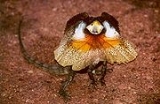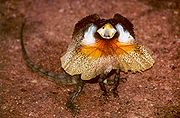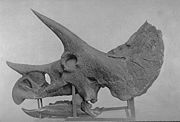
Neck frill
Encyclopedia


Reptile
Reptiles are members of a class of air-breathing, ectothermic vertebrates which are characterized by laying shelled eggs , and having skin covered in scales and/or scutes. They are tetrapods, either having four limbs or being descended from four-limbed ancestors...
s with either a bony
Bone
Bones are rigid organs that constitute part of the endoskeleton of vertebrates. They support, and protect the various organs of the body, produce red and white blood cells and store minerals. Bone tissue is a type of dense connective tissue...
support such as those present on the skull
Skull
The skull is a bony structure in the head of many animals that supports the structures of the face and forms a cavity for the brain.The skull is composed of two parts: the cranium and the mandible. A skull without a mandible is only a cranium. Animals that have skulls are called craniates...
s of dinosaur
Dinosaur
Dinosaurs are a diverse group of animals of the clade and superorder Dinosauria. They were the dominant terrestrial vertebrates for over 160 million years, from the late Triassic period until the end of the Cretaceous , when the Cretaceous–Paleogene extinction event led to the extinction of...
s of the suborder Marginocephalia
Marginocephalia
Marginocephalia is a clade of ornithischian dinosaurs that includes the thick-skulled pachycephalosaurids, and horned ceratopsians. They were all herbivores, walking on two or four legs, and are characterized by a bony ridge or frill the back of the skull...
or a cartilaginous
Cartilage
Cartilage is a flexible connective tissue found in many areas in the bodies of humans and other animals, including the joints between bones, the rib cage, the ear, the nose, the elbow, the knee, the ankle, the bronchial tubes and the intervertebral discs...
one as in the Frill-necked Lizard
Frill-necked Lizard
The frill-necked lizard , also known as the frilled lizard or frilled dragon, is found mainly in northern Australia and southern New Guinea. Its name comes from the large frill around its neck, which usually stays folded against the lizard's body. It is largely arboreal, spending the majority of...
. In technical terms, the bone-supported frill is composed of an enlarged parietal bone
Parietal bone
The parietal bones are bones in the human skull which, when joined together, form the sides and roof of the cranium. Each bone is roughly quadrilateral in form, and has two surfaces, four borders, and four angles. It is named from the Latin pariet-, wall....
flanked by elongated squamosal
Squamosal
The squamosal is a bone of the head of higher vertebrates. It is the principal component of the cheek region in the skull, lying below the temporal series and otic notch and bounded anteriorly by postorbital. Posteriorly, the squamosal articulates with the posterior elements of the palatal complex,...
s and sometimes ringed by epoccipital
Epoccipital
Epoccipital is an anatomical term for the distinctive bones found lining the frills of ceratopsid dinosaurs. The name is a misnomer, as they are not associated with the occipital bone. Epoccipitals begin as separate bones that fuse during the animal's growth to either the squamosal or parietal...
s, bony knobs that gave the margin a jagged appearance. In the early 1900s, the parietal bone was known among paleontologists as the dermosupraoccipital. In some genera
Genus
In biology, a genus is a low-level taxonomic rank used in the biological classification of living and fossil organisms, which is an example of definition by genus and differentia...
, such as Triceratops
Triceratops
Triceratops is a genus of herbivorous ceratopsid dinosaur which lived during the late Maastrichtian stage of the Late Cretaceous Period, around 68 to 65 million years ago in what is now North America. It was one of the last dinosaur genera to appear before the great Cretaceous–Paleogene...
, Pentaceratops
Pentaceratops
Pentaceratops is a genus of ceratopsid dinosaur from the late Cretaceous Period of what is now North America. The appearance of Pentaceratops sternbergii in the fossil record marks the end of the Judithian land vertebrate age and the start of the Kirtlandian...
,Centrosaurus
Centrosaurus
Centrosaurus is a genus of herbivorous ceratopsian dinosaurs from the late Cretaceous of Canada. Their remains have been found in the Dinosaur Park Formation and uppermost Oldman Formation, dating from 76.5 to 75.5 million years ago....
and Torosaurus
Torosaurus
Torosaurus is a genus of ceratopsid dinosaur that lived during the late Cretaceous period , between 70 and 65 million years ago. It possessed one of the largest skulls of any known land animal. The frilled skull reached in length...
, this extension is very large. Despite the neck frill predominantly being made of hard bone, some neck frills are made of skin, as is the case with the Frill-necked Lizard of today that resides in Australia
Australia
Australia , officially the Commonwealth of Australia, is a country in the Southern Hemisphere comprising the mainland of the Australian continent, the island of Tasmania, and numerous smaller islands in the Indian and Pacific Oceans. It is the world's sixth-largest country by total area...
.
The use of the neck frill in dinosaurs is relatively unknown; it may have been used for thermoregulation
Thermoregulation
Thermoregulation is the ability of an organism to keep its body temperature within certain boundaries, even when the surrounding temperature is very different...
or simply as a defense mechanism. Indeed, during battles for territory, competing Triceratops crashed heads together with their elongated horns and the neck frill may have been employed as a kind of shield, protecting the rest of the animal from harm. However, usage of the neck frill in modern reptiles is better documented. Two chief and disparate examples are the Horned Lizard
Horned lizard
Horned lizards are a genus of lizards which are the type genus of the family Phrynosomatidae. The horned lizard is popularly called a "horned toad", "horny toad", or "horned frog", but it is neither a toad nor a frog. The popular names come from the lizard's rounded body and blunt snout, which...
s (genus Phrynosoma) with a bony frill, and the Frill-necked Lizard (Genus Chlamydosaurus) with a cartilaginous frill. The Frill-necked Lizard's frill is mainly made up of flaps of skin, which are usually coloured pink, supported by cartilaginous spines. Similar to the portrayal of the dinosaur Dilophosaurus
Dilophosaurus
Dilophosaurus was a theropod dinosaur from the Sinemurian stage of the Early Jurassic Period, about 193 million years ago. The first specimens were described in 1954, but it was not until over a decade later that the genus received its current name...
in Steven Spielberg
Steven Spielberg
Steven Allan Spielberg KBE is an American film director, screenwriter, producer, video game designer, and studio entrepreneur. In a career of more than four decades, Spielberg's films have covered many themes and genres. Spielberg's early science-fiction and adventure films were seen as an...
's Jurassic Park
Jurassic Park (film)
Jurassic Park is a 1993 American science fiction adventure film directed by Steven Spielberg. The film is based on the novel of the same name by Michael Crichton. It stars Sam Neill, Laura Dern, Jeff Goldblum, Richard Attenborough, Martin Ferrero, and Bob Peck...
, the Frill-necked Lizard can puff out these neck frills either side of its head when threatened. The lizards often raise their frills when battling for territory or when making themselves seem bigger when threatened. There is however, no evidence that suggests that Dilophosaurus had the same abilities, as many of its features in the Jurassic Park film were purely fictional.
Numerous other animals of both modern and prehistoric times use both skin or bone protrusions to make themselves seem more threatening, attract mates or to thermoregulate. Examples of these are the usage of dewlap
Dewlap
A dewlap is a longitudinal flap of skin that hangs beneath the lower jaw or neck of many vertebrates. While the term is usually used in this specific context, it can also be used to include other structures occurring in the same body area with a similar aspect, such as those caused by a double...
s and crest
Sagittal crest
A sagittal crest is a ridge of bone running lengthwise along the midline of the top of the skull of many mammalian and reptilian skulls, among others....
s in lizards, dinosaurs and birds.

